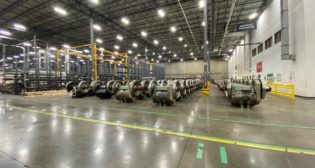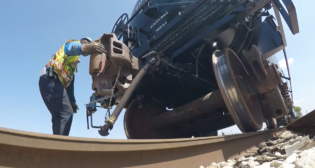
New York Air Brake marks 125 years
Written by William C. Vantuono, Editor-in-ChiefThe Watertown, N.Y.-based railway supplier was founded in 1890 and was among the first companies to manufacture air brake control valves for freight trains. “The company continues that tradition today with products that help the nation’s railroads move consumer goods, commodities, energy resources, and other freight safely and efficiently,” said Hawthorne. NYAB employs more than 800 skilled workers at production facilities in Watertown; China Grove, N.C.; West Chicago, Ill.; and Irving, Tex (the TDS, Train Dynamic Systems, business unit). The company manufactures brake controls and air supply and bogie equipment, and provides rail services “while teams of designers continue their work to engineer products that outperform existing technology to make freight trains safer, more efficient, and more productive,” noted Hawthorne.
NYAB’s earliest automatic brake valves (a vacuum-actuated design) replaced manual braking and made brakes more effective and trains safer, enabling railroads to operate longer and heavier freight trains. In 1902, the company moved its operations from Beebee Island in the center of Watertown to a location then on the outskirts of the city. (Its operations were converted from brake valves to munitions during both World War I and II.) Throughout the 20th century, NYAB grew through acquisitions and new products, eventually merging with General Signal Corporation in 1967. The company temporarily faltered in 1983 as a result of a decrease in demand for its railroad freight products, but an expansion into equipment for the rail transit industry enabled the company’s return to prosperity. NYAB was acquired by the German brake company Knorr-Bremse in 1991.
“The recent boom in domestic energy production is accelerating economic growth in America,” said Hawthorne. “Our new and existing products and services are an integral part of moving our nation’s energy resources to market safely and reliably, especially crude by rail. The past five years have seen a dramatic rise in U.S. oil production, reversing decades of decline and making the nation a net energy exporter. This energy expansion has fueled economic growth as manufacturers and other commercial energy users take advantage of lower-prices for energy supplies to bring manufacturing operations back to U.S. plants and workers. U.S. freight railroads are seeing a boom in the transport of crude oil from the oil fields to refineries and markets. However, a series of oil train accidents has raised questions about the safety of moving crude by rail. In response, U.S. freight railroads and car owners voluntarily proposed new safety standards that mandate the continued introduction of more robust tank cars and improved train control systems. These improvements are essential to the continued supply of safe, low cost energy for America and its economic engine.”
In response, since the beginning of the oil boom, NYAB “has launched research and development efforts to introduce new technology to make oil trains, and all freight trains, safer,” said Hawthorne. “Beginning Jan. 1, 2015, a new and safer air brake control valve will be manufactured in Watertown that ensures there is always air pressure available to activate freight car brakes, regardless of how long the engineer applies the brakes. This new control device, called the DB-60 II, is the most significant improvement to pneumatic air brake control valves in 40 years. “
“The DB-60 II, with our new BCM (Brake Cylinder Maintainer) feature, builds on our strategy to design products that are ‘Engineered to Outperform’ existing technology,” noted Hawthorne. “Other innovations to make freight trains safer include LEADER (Locomotive Engineer Assist/Display Event Recorder), which gives engineers real-time information about their train and the track ahead so that brake and throttle settings can be optimized to minimize in-train forces and maximize safety. The EP-60 Electronically-Controlled Pneumatic (ECP) brake system uses electronic signals rather than air pressure to apply and release all the brakes simultaneously throughout a train to bring it to a smoother, faster stop. Our oil-free air compressor supplies clean air to the brake system and requires fewer filters and much less maintenance. Our patented WheelSaver brake shoe repairs damaged wheels while the train is in operation.”
New York Air Brake’s customers include BNSF Railway, CN, Canadian Pacific, CSX Transportation, Kansas City Southern, Norfolk Southern, and Union Pacific. While a majority of the company’s business comes from North American customers, ever increasing exports to freight rail customers in Europe, Australia, China, South Africa, and Brazil represent a growing part of the company’s portfolio.



